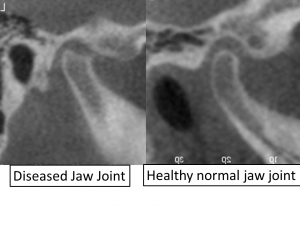Temporomandibular Disorder
The challenge with diagnosing TM disorder is identifying the exact source and cause of the pain and dysfunction. For example, the nerve to the TMJ is a branch of the trigeminal nerve. An injury to this nerve in the TMJ may be confused with neuralgia because the symptoms appear to be the same. The two bones of the TMJ are held together by a series of ligaments, any of which can be damaged. Damaged TMJ ligaments usually result in the displacement of the TMJ disc (clicking or popping) or joint sprain (pain) — or both. This is an intracapsular origin of pain and dysfunction. Another possible source of disorder may be from the muscles, their tendons and attachments that move the TMJ, mandible or related osseous structures. This is a myogenous or extracapsular origin of pain and dysfunction. Any one combination of such injuries could produce pain and dysfunction in the TMJ, abnormal movement and function of the mandible. Careful diagnostic study and testing is needed to determine the precise source of any TMJ disorder.
There is also possibility of the following:
- abnormal growth within the TMJ
- various types of arthritis
- bone remodeling due to prolonged abnormal functional load to the joints
- joint infections and symptoms related to Lyme’s disease.

Besides from obvious trauma such as personal assault, motor vehicle accidents or sports whiplash and concussion, most cases of TMJ disorder are simply or sometimes complexly micro-trauma injuries. That is, they result from undetected chronic jaw clenching and sleep rhythmic masticatory muscle activity — a disruption in the nerve signal to the jaw function and muscle harmony. This is usually accompanied by pain from inflammation. Many people have TMJ signs or symptoms. However, they may not have enough significant pain or disruptive TMD symptoms for them to seek treatment until their body’s coping mechanism suffers from the effect of inflammation.
Inflammation is one of the chronic stressors to the body. It could be caused by local areas such as the TMJ or its related musculoskeletal structures. It could also arise from distal areas such as the neck, shoulders, arms, spinal column, hip and knees and feet. Other conditions that cause chronic stress to the nervous system could also aggravate the TMJ as the patient expresses pain through unconscious clenching and facial expression. These conditions include, but are not limited to, a whole collection of mysterious chronic diseases such as fibromyalgia, chronic fatigue, obstructive sleep apnea, irritable bowel diseases, multiple chemical sensitivity, interstitial cystitis, emotional distress and myofascial pain. Hence, decades of research have confirmed the multifactorial nature of TMJ disorder. For the same reason, success in treatment for TMD has been claimed by healthcare workers with different expertise.
